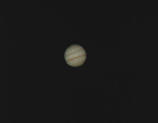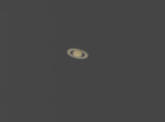Edinburgh Imaging Visit
OOn Monday 14th January six members of AFA travelled to the meeting of the imaging section of the Astronomical Society of Edinburgh at the Calton Hill observatory. The weather didn't look too promising when we left Falkirk and it was anticipated that there would be a short talk and show of images. By the time we arrived, the sky was about 90% clear and after being welcomed by Lorna McCalman and Neil Grubb followed by some general chat the Cooke 6" refractor was brought into use.

This telescope was erected in 1896 and is the observatory's main instrument. It has been restored by Charles Frank Ltd and its massive equatorial mount and fine optics give excellent high magnification views of the night sky.The first object was focused on was Jupiter, and what an object, the north and south equatorial bands the moons and a shadow transit in all their glory. As if by magic, digital cameras were produced and using eyepiece projection, images were gathered profusely. One of the great advantages of digital photography is that one takes lots of photographs without worrying about the cost of film and processing and you are able to immediately view the images and discard any not worthy of a place in the history books! After Jupiter, Saturn's turn and again it was 'Wow' with the Cassini division and Titan clearly visible.

Downstairs, Jim Ward had brought a new webcam with him and he and Neil Grubb modified it to fit on the eyepiece of a telescope. Once that was done, the software was loaded into Neil's laptop computer and his 8" LX 10 telescope set up outside. The webcam was fitted to the telescope then connected to the laptop and low and behold, a 'picture'. New out of it's box, modified and showing images in less than twenty minutes. The beauty of a set-up like this, is that a group of observers can see the view through a telescope at the same time but the main object of the exercise is taking images of the heavens. Images of Jupiter, Saturn, the Trapezium in Orion and the double star, Castor in Gemini was separated, (actually a multiple star of 6 separate components) were all viewed and recorded on the laptop. Great stuff!!! For the record, the webcam was an Aiptek hyper V-cam. with VGA resolution of 640 X 480 pixels, which is large, the sensitivity is good and it is simple to use. After opening it up and removing the lens and switch, the modification was completed by the addition of a 35mm. film container with the base cut off which acts as the coupling between camera and telescope. (See Neil's website for details)
Another of the Edinburgh members had her new Helios Star Travel 102mm. short tube refractor and this was also set up outside. A nice looking telescope, well suited to planetary and lunar work and also giving good wide field viewing. Reluctantly we had to make our way home but with the sights we had seen firmly fixed in our minds and in some cases carefully carried in digital form.